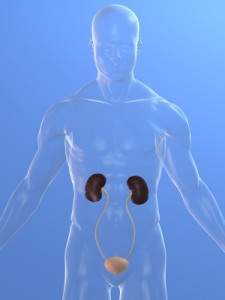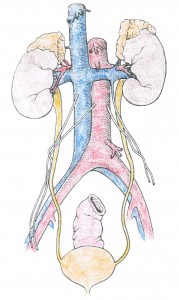Definition: What is a kidney stone?
Before we explore what kidney stones are, it is important to understand the basic anatomy and function of the urinary system. The urinary system is made up of the kidneys, the ureters, bladder, and urethra.
The kidneys act as filters for the blood, removing any waste products. These waste products are passed out of the body through our urine. The urine passes from the kidneys, through the ureters (which are essentially like two pips that transport urine) to the bladder. The bladder is where urine is stored until you are ready to urinate.
Kidney stones (nephrolithiasis) form from the crystallization of different substances within the kidney. This happens for a variety of reasons. These stones formed within the kidney are then typically released into the ureter (at this point the condition is called urolithiasis). Symptoms (pain, etc.) can occur if these stones are large enough to obstruct the kidney or ureter.
There are four different types of kidney stones. They are named based on the substance from which they are formed.
What are the types of kidney stones?
The four types of kidney stones are:
Calcium
Calcium oxalate stones are the most common type of kidney stone. They represent almost 70-80% of all stones. They are caused by a build-up of calcium and oxalate (more common) or phosphate. While there are many reasons for why calcium stones form, calcium intake, too little fluid intake, or even too much Vitamin C consumption are some of the more well recognized causes.
Uric Acid
This type of kidney stone can be caused by urine that is too acidic or in individuals with gout. It results from the buildup of uric acid.
Struvite
Struvite kidney stones are uncommon (1% of all renal stones). They are typically caused by certain bacteria that may infect the kidney. Stones are comprised of magnesium, phosphate and ammonium.
Cystine
Cystine stones are quite rare and usually only found in people with genetic condition called cystinuria. This condition makes them unable to reabsorb a normal body chemical, called cystine. As a result, they excrete an abnormal amount of cystine which can crystallize, forming stones.
Characteristics & Size of Kidney Stones & Ureters
Kidney stones come in different shapes and sizes. They can be as small as a grain of sand to several inches in diameter. The size and location of the stone determines how it affects you and if treatment is necessary, how you will be treated.
As mentioned prior, the ureter is a tube (about 25-30 cm long) that is made up of smooth muscle fibers. This tube that carries urine from the kidney to the bladder averages 3-4 mm in diameter.
Because it is a muscle with some ability to expand, typically kidneys stones that are less than 5 mm can move through the ureter without issue (i.e. most of the time, it will not cause any symptoms).
Kidney stones that are larger than 5 mm are often too large to pass through the ureter spontaneously. Oftentimes, treatment is needed. Bottom line, the larger the stone, the less likely it will pass on its own.
For reference, 6mm, 7mm and 8mm kidney stones are .23 inches, .27 inches and .31 inches in width respectively, making an 8mm kidney stone about the size of a small kernel of corn.
Ultimately, the make-up, size, and location of the kidney stone will determine the treatment necessary (if it is necessary).
Signs & Symptoms of kidney stones
While many times, kidneys stones pass through the urinary system without issue, sometimes they may cause problems. Signs and symptoms of problematic kidney stones may include:
- Pain in the lower back or sides
- Blood in urine
- Decrease in urinary output (not peeing as much)
 Diagnosis of kidney stones
Diagnosis of kidney stones
If you think you might have kidney stones, talk to your doctor. Your healthcare provider may do the following diagnostic tests:
- Imaging studies (usually computed tomography (CT) is the imaging study of choice)
- Urine test
- Blood test
- Analysis of the passed stone
Prevention of kidney stones
Knowing what kind of kidney stone you are more prone to may help in the prevention. In general the number 1 way to avoid kidney stones is to stay hydrated. So drink plenty of water throughout the day (64-96 ounces recommended).
Calcium Kidney Stone
- Calcium-based foods do not cause kidney stones, but calcium supplements can. Make sure you check with your doctor to see if you should stop taking a calcium supplement or continue (make sure you are taking it with food).
- In calcium stones, the oxalate that combines with the calcium to form the stone can be acquired through diet and these foods should be avoided: spinach, swiss chard, okra, bran flakes, rhubarb, soy products, french fries, potato chips, sweet potatoes, chocolate, tea, black pepper and nuts.
Uric Acid Kidney Stone
- Avoid acidic juices and foods that may cause your urine to be more acidic. Also avoid foods that contain high amounts of uric acid such as: alcohol, organ meats (liver, kidney), spinach, sardines and some other fish and seafood, bacon, turkey, veal and venison.
Treatment for Kidney Stones (i.e. how to prevent and/or get rid of a kidney stone)
Drink Water!
Unless you have a medical condition where your physician does not recommend you to increase your water intake, drink 64-96 ounces of water daily. You should have clear or nearly clear colored urine. Drinking water alone may act to flush the stone through the ureter more quickly and less painfully.
Dietary Changes:
Dietary changes may help to break up, dissolve or shrink the kidney stone–especially if you have a Calcium or Uric Acid stone, as these substances may be acquired through diet.
Calcium Kidney Stone
Calcium-based foods do not cause kidney stones, but calcium supplements can. Make sure you check with your doctor to see if you should stop taking a calcium supplement or continue (make sure you are taking it with food).
In calcium stones, the oxalate that combines with the calcium to form the stone can be acquired through diet and these foods should be avoided: spinach, swiss chard, okra, bran flakes, rhubarb, soy products, french fries, potato chips, sweet potatoes, chocolate, tea, black pepper and nuts.
Uric Acid Kidney Stone
If you have a history of gout or are history of uric acid stones, avoid foods that contain high amounts of uric acid. These foods include: organ meats (liver, kidney), spinach, sardines and some other fish and seafood, bacon, turkey, veal and venison. Alcohol consumption can also increase your uric acid levels.
Surprisingly, lemons have been known to help prevent the formation of kidney stones. Try adding a few slices of lemon or splashes of lemon juice to your water.
Pain Management:
Unless you have a medical condition that does not allow you to take over the counter pain medications such as Tylenol, Ibuprofen, or Aleve–take these medications according to package instructions. Pain can be mild to severe when passing a stone and pain is important to manage during this time.
Medications:
Your physician, nephrologist or urologist may prescribe a medication that works as a muscle relaxant for you to help pass the stone. As mentioned previously, the ureter is a muscle, and taking a medication that allows it to relax and expand will aid in the passing of a kidney stone.
For stones that are not expected to be able to pass on their own (6-7 mm or larger) the following treatment options may be recommended:
Sound Waves:
This procedure is called an Extracorporeal Shock Wave Lithotripsy or ESWL, and essentially the idea is that sound waves (via ultrasound) are used to locate the kidney stone (from the outside of the body). Then sound waves are sent to the kidney stone which breaks it into smaller pieces that can pass through the ureter on their own. Sometimes, in very large stones, this needs to be done more than once. This treatment can be very effective.
Surgery:
Your doctor may recommend percutaneous nephrolithotomy (PCNL) surgery if other measures fail. In this surgical procedure, the kidney stone is accessed through an incision in the patient’s back. It is then either removed or broken into smaller pieces that can pass out on their own. This type of procedure is relatively successful in treating larger kidney stones.
Scope:
A ureteroscopy or Retrograde Intrarenal Surgery (RIRS) is another option that your doctor may recommend. During this procedure, a scope is inserted into the urethra, through the bladder and into the ureter until the stone is located. Once located, it may either be removed or broken into smaller pieces that can pass out on their own. Additionally, a temporary stent may be placed to widen the ureter, which may help any remaining stones to pass.
Parathyroid Gland Examination:
In people who have recurrent issues with calcium-oxalate kidney stones, the parathyroid gland (located near the throat) may be examined to see if it is over producing parathyroid hormone. Parathyroid hormone is what increases the calcium levels in our blood. When the gland is producing too much hormone, this can lead to too much calcium in the blood which is then passed through the kidneys. This can lead to the development of calcium stones. If you are found to have an overactive parathyroid gland (hyperparathyroidism), treatment may consist of medications or surgery.
I think have a kidney stone–what should I do?
If you think you have a kidney stone, call your doctor. They will likely want to see you in the office. Depending on your symptoms, they may order an imaging test to determine the size and location of the stone. This will determine what treatment options are best.
As mentioned prior, oftentimes the stone is small enough to pass on its own in. If this is suspected, you will be advised to do this in the comfort of your own home.
Note that the information in this article is purely informative and should never be used in place of the advice of your treating physicians.
